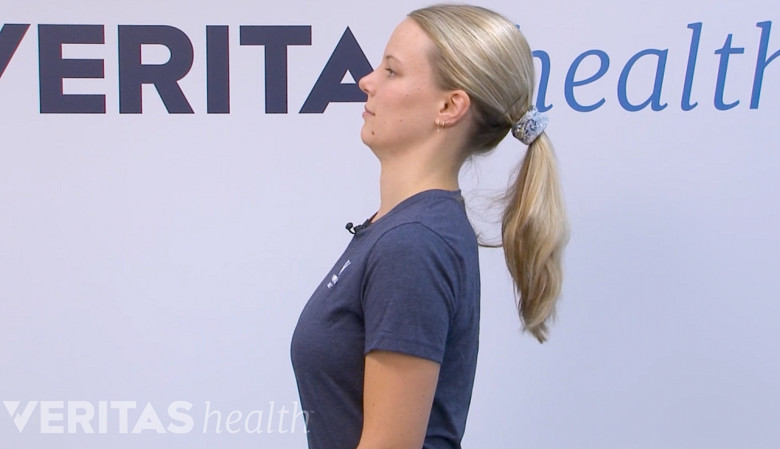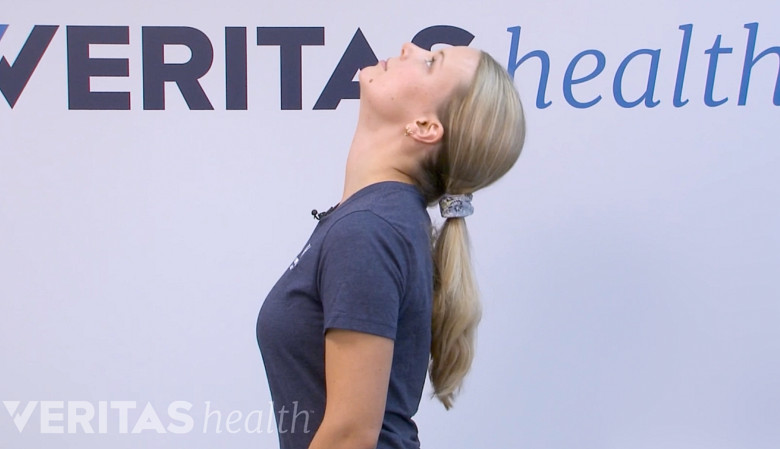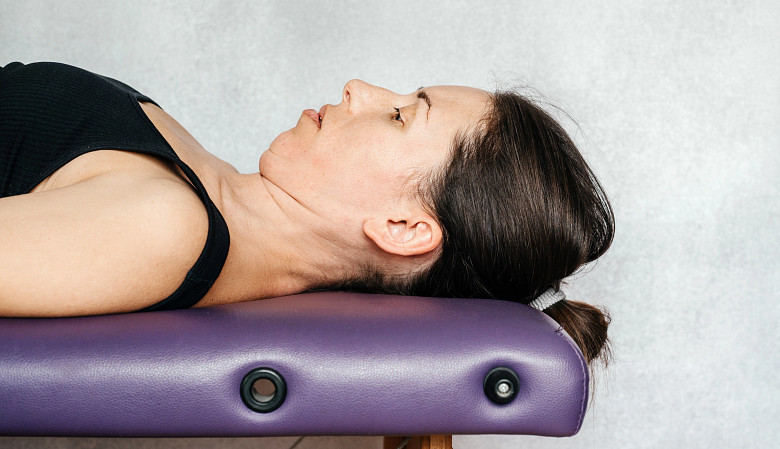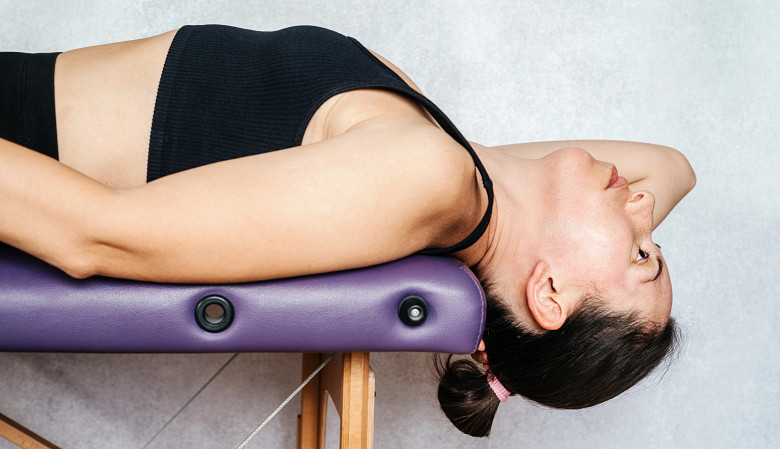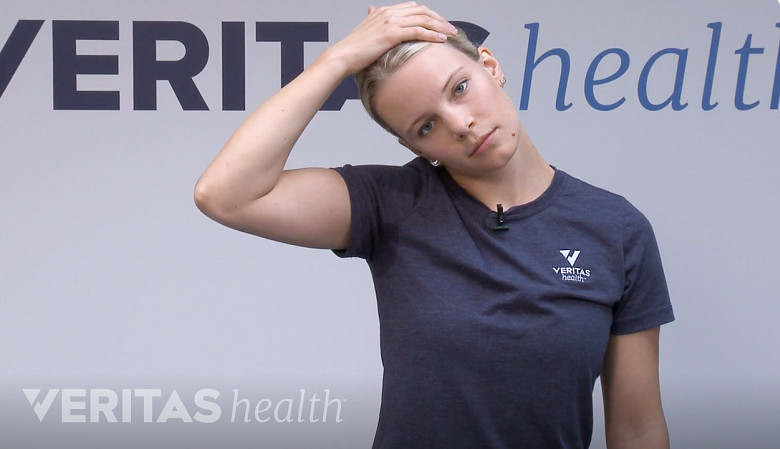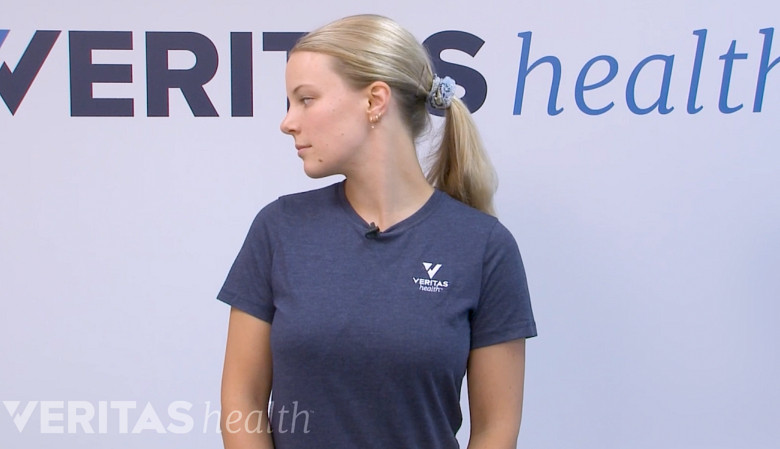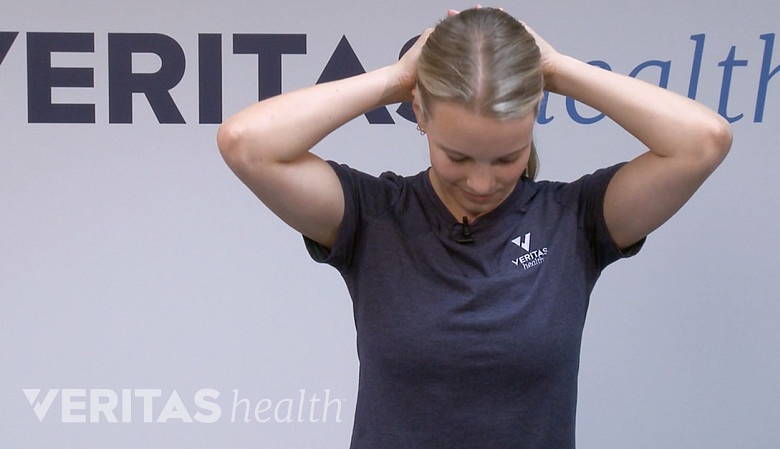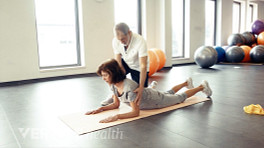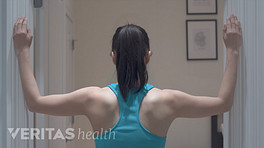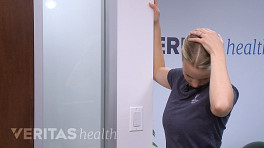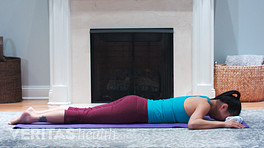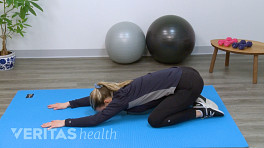McKenzie therapy for neck and arm pain (radicular pain) includes a set of therapeutic exercises formulated to relieve acute arm symptoms and restore motion in the neck.
The exercises are meant to be continued even after the pain subsides or goes away – in order to treat the underlying cause and prevent recurrences.
In This Article:
- What Is the McKenzie Method for Back Pain and Neck Pain?
- 7 McKenzie Method Exercises for Back Pain and Sciatica
- 7 McKenzie Method Exercises for Neck Pain and Arm Pain
- Video: What Is the McKenzie Method?
Illustrations and Instructions for 7 McKenzie Method Exercises for Neck Pain and Arm Pain
McKenzie’s neck exercise program consists of 7 standard exercises. These exercises are performed in sitting and lying positions and involve movements that turn the head and bend the neck in different directions.
A good response is centralization of arm pain (movement of pain from the arm closer to the spine) or even some temporary increase in neck pain as symptoms move closer to their origin, or a reduction in neck pain if no arm pain is present.
The exercises should be performed under the guidance of a trained therapist. Numerous modifications can be made in position and amount of force applied to the spine, so if you are unable to find relief with these exercises, a trained practitioner may be able to personalize them better for you.
If the neck and/or arm pain symptoms worsen or become intolerable, preventing you from performing these exercises, a physician should be consulted before attempting any of them.
Neck exercise #1: Head retraction in sitting
Head retraction means to pull the head backward. To perform this exercise:
- Sit on a chair in a relaxed position and look straight. In a relaxed position, the head slightly protrudes forward.
- Slowly pull the head backward as far as possible.
- Continue looking straight and make sure the head is not tilted.
- Hold the pose for 2 to 3 seconds and return to the starting position.
Perform 10 repetitions of this exercise every 2 hours during the day. With each repetition, aim to pull the head back more than before.
This exercise prepares the body for the second exercise.
If you find some pain relief with this exercise, but it does not fully alleviate your neck and/or arm symptoms, you can still move on to the second exercise. It is important to note that you should be able to move your neck to its full range of retraction before moving on to the second exercise.
Neck exercise #2: Neck extension in sitting
Extension means to bend backward.
Exercise 2 should always follow exercise 1. To perform this exercise:
- Start in the seated position and perform the steps of exercise 1.
- Hold your head in the retracted position of exercise 1.
- Lift your chin and tilt your head backward as if you were looking at the ceiling.
- Gently turn your head half an inch to the right and then half an inch to the left for 5 seconds.
- Return to the starting position.
Perform 10 repetitions of this exercise every 2 hours during the day. With each repetition, aim to pull the head back more than before.
Neck exercise #3: Head retraction in lying
If exercises 1 and 2 are too painful, this exercise can be a great alternative as it takes the pressure of gravity off the cervical spine (neck).
To perform this exercise:
- Lie face-up across a bed with your head near the free-standing edge of the bed (there should be no headboard behind you). Rest your shoulders flat, and don’t use a pillow.
- Push the back of your head into the mattress. At the same time, tuck your chin in so your neck moves backward.
- The head and neck should move backward at the same time.
Maintain this position for a few seconds and return to the starting position.
Perform 10 repetitions of this exercise every 2 hours during the day. With each repetition, aim to pull the head back more than before.
This exercise prepares the body for exercise 4.
Neck exercise #4: Neck extension in lying
Exercise 4 should always follow exercise 3 and should be attempted only if exercise 3 does not worsen arm pain.
To perform this exercise:
- Start by lying in the same position as in exercise 3 — across the free-standing edge of the bed and without a pillow.
- Place your hand under your head and slowly move farther out so your head is over the edge of the bed.
- Gently lower your head down so your neck tilts backward, and you can see the floor.
- Bring your head and neck as far backward as possible.
- Slowly, turn your head half an inch to the right and half an inch to the left.
- With each turn, attempt to move your head and neck farther backward.
- When you have extended your neck to the maximum, stop turning and relax in this position for 2 to 3 seconds.
- Support your head with your hand and move back on the bed to the starting position.
While performing this exercise, do not get up immediately or move your head abruptly.
Perform this exercise once every 2 hours during the day.
Neck exercise 5: Side bending of the neck
If there is no relief from the previous neck retraction and extension exercises, it is appropriate to try exercise 5.
Before starting this exercise, warm up with exercise 1. To perform this exercise:
- Sit upright on a chair and look straight ahead.
- Hold your head in the retracted position of exercise 1.
- While continuing to look ahead, bend your neck sideways (bring your ear closer to your shoulder) to tilt your head to the painful side.
- Gently pull the head farther down using your hand.
- Maintain this position for a few seconds and return to the starting position.
Perform 10 repetitions of this exercise every 2 hours during the day. Remember to always bend toward the painful side only.
Neck exercise #6: Neck rotation
In McKenzie therapy, neck rotation refers to turning the head to the right and left.
For those who find exercise 5 too painful or stiff, this rotation exercise offers a gentler option.
Before starting this exercise, warm up with exercise 1. To perform this exercise:
- Sit upright on a chair and look straight ahead.
- Hold your head in the retracted position of exercise 1.
- While keeping the head retracted, gently turn your head as far as possible to the right and then to the left.
- If one side is more painful than the other, perform the neck rotation only on the painful side.
- Once the pain subsides, continue the exercise on both sides.
Perform 10 repetitions of this exercise every 2 hours during the day.
Neck exercise #7: Neck flexion in sitting
Flexion means to bend forward. To perform this exercise:
- Sit on a chair, relax your body, and look straight ahead.
- Drop your head forward and let it hang loose so your chin is as close as possible to your chest.
- Place both hands behind your head and lock your fingers.
- Relax your arms and point your elbows to the floor.
- Let the weight of your arms pull your head down farther.
- Maintain this position for a few seconds and return to the starting position.
Perform 2 to 3 repetitions of this exercise every 2 hours during the day.
Always perform neck exercises 1 and 2 after completing exercise 7.
When and How to Do the McKenzie Method Neck Exercises
The 7 neck exercises are performed in phases depending on the severity of symptoms and duration of pain. Following the recommended number of repetitions and sessions provides the full benefit of the exercises.
- When in acute, constant pain, perform exercise 1 and slowly add exercise 2. Perform these exercises for the first few days until the acute symptoms begin to subside.
1
McKenzie R, Kubey C. 7 Steps to a Pain-Free Life: How to Rapidly Relieve Back and Neck Pain Using the McKenzie Method. Updated edition. Plume; 2014.
Gradually incorporate exercise 3 into the daily exercise sessions and then move on to exercise 4. When the severity of pain reduces significantly (after 1 or 2 days of performing exercises 3 and 4), stop exercises 3 and 4 and continue exercises 1 and 2. 1 McKenzie R, Kubey C. 7 Steps to a Pain-Free Life: How to Rapidly Relieve Back and Neck Pain Using the McKenzie Method. Updated edition. Plume; 2014.
If there is no pain relief from exercises 2-4, perform exercise 5 for 2 days. Exercise 5 helps distribute the pain more evenly across the spine. When the pain has reduced, resume exercises 1 and 2. 1 McKenzie R, Kubey C. 7 Steps to a Pain-Free Life: How to Rapidly Relieve Back and Neck Pain Using the McKenzie Method. Updated edition. Plume; 2014. - When the acute pain has reduced, exercises 6 and 7 help reduce pain and stiffness while bending the neck or turning the head.
1
McKenzie R, Kubey C. 7 Steps to a Pain-Free Life: How to Rapidly Relieve Back and Neck Pain Using the McKenzie Method. Updated edition. Plume; 2014.
- To manage pain while turning the head to the left or right, perform exercise 6.
- To manage pain while bending the neck downward, perform exercise 7.
Do these exercises for 2 to 3 weeks. Stiffness usually takes a longer time to subside and may require 3 to 6 weeks of therapy sessions to restore full function. After each session, perform exercises 1 and 2 to cool down the body. 1 McKenzie R, Kubey C. 7 Steps to a Pain-Free Life: How to Rapidly Relieve Back and Neck Pain Using the McKenzie Method. Updated edition. Plume; 2014.
- When there is no pain or stiffness:
- Perform exercise 6 followed by exercises 1 and 2 every morning and evening to prevent a recurrence of neck pain and maintain flexibility in the neck. 1 McKenzie R, Kubey C. 7 Steps to a Pain-Free Life: How to Rapidly Relieve Back and Neck Pain Using the McKenzie Method. Updated edition. Plume; 2014.
- Perform exercises 1 and 2 at regular intervals during sitting to keep the neck conditioned. 1 McKenzie R, Kubey C. 7 Steps to a Pain-Free Life: How to Rapidly Relieve Back and Neck Pain Using the McKenzie Method. Updated edition. Plume; 2014.
During each session, the exercises should progressively alleviate symptom severity or make them tolerable. Despite occasional pain flare-ups, symptoms are expected to diminish after subsequent sessions. Maintaining a supported posture throughout the day makes these exercises more effective and relieves pain faster. 1 McKenzie R, Kubey C. 7 Steps to a Pain-Free Life: How to Rapidly Relieve Back and Neck Pain Using the McKenzie Method. Updated edition. Plume; 2014.
If any exercise increases the severity of symptoms hindering the continuation of the workout program, consultation with a physician is advised.
- 1 McKenzie R, Kubey C. 7 Steps to a Pain-Free Life: How to Rapidly Relieve Back and Neck Pain Using the McKenzie Method. Updated edition. Plume; 2014.

